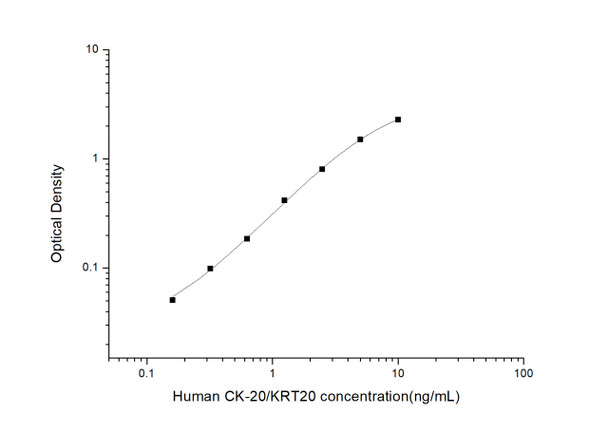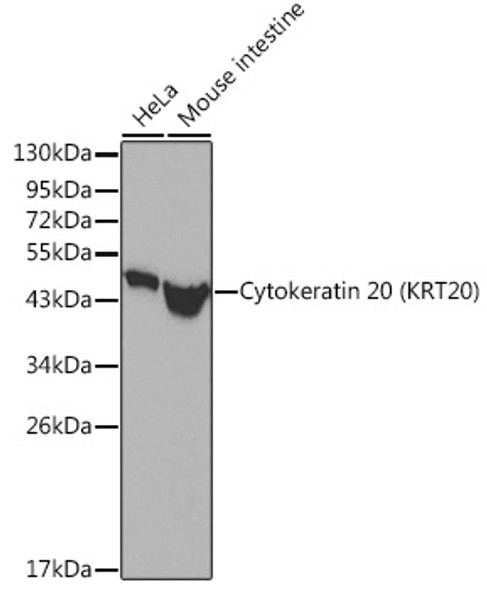Human Cell Death ELISA Kits
Human CK-20/KRT20 (Cytokeratin 20) ELISA Kit (HUES02987)
- SKU:
- HUES02987
- Product Type:
- ELISA Kit
- Size:
- 96 Assays
- Uniprot:
- P35900
- Sensitivity:
- 0.09ng/mL
- Range:
- 0.16-10ng/mL
- ELISA Type:
- Sandwich
- Reactivity:
- Human
- Sample Type:
- Serum, plasma and other biological fluids
- Research Area:
- Cell Death
Description
| Assay type: | Sandwich |
| Format: | 96T |
| Assay time: | 4.5h |
| Reactivity: | Human |
| Detection Method: | Colormetric |
| Detection Range: | 0.16-10 ng/mL |
| Sensitivity: | 0.10 ng/mL |
| Sample Volume Required Per Well: | 100µL |
| Sample Type: | Serum, plasma and other biological fluids |
| Specificity: | This kit recognizes Human CK-20/KRT20 in samples. No significant cross-reactivity or interference between Human CK-20/KRT20 and analogues was observed. |
This ELISA kit uses Sandwich-ELISA as the method. The micro ELISA plate provided in this kit has been pre-coated with an antibody specific to Human CK-20/KRT20. Standards or samples are added to the appropriate micro ELISA plate wells and combined with the specific antibody. Then a biotinylated detection antibody specific for Human CK-20/KRT20 and Avidin-Horseradish Peroxidase (HRP) conjugate are added to each micro plate well successively and incubated. Free components are washed away. The substrate solution is added to each well. Only those wells that contain Human CK-20/KRT20, biotinylated detection antibody and Avidin-HRP conjugate will appear blue in color. The enzyme-substrate reaction is terminated by adding Stop Solution and the color turns yellow. The optical density (OD) is measured spectrophotometrically at a wavelength of 450 nm ± 2 nm. The OD value is proportional to the concentration of Human CK-20/KRT20. The concentration of Human CK-20/KRT20 in samples can be calculated by comparing the OD of the samples to the standard curve.
| UniProt Protein Function: | Function: Plays a significant role in maintaining keratin filament organization in intestinal epithelia. When phosphorylated, plays a role in the secretion of mucin in the small intestine |
| UniProt Protein Details: | By similarity. Ref. 4 Ref. 8 Subunit structure: Heterotetramer of two type I and two type II keratins. Associates with KRT8. Subcellular location: Cytoplasm Ref. 6 Ref. 7. Tissue specificity: Expressed predominantly in the intestinal epithelium. Expressed in luminal cells of colonic mucosa. Also expressed in the Merkel cells of keratinized oral mucosa; specifically at the tips of some rete ridges of the gingival mucosa, in the basal layer of the palatal mucosa and in the taste buds of lingual mucosa. Ref. 6 Ref. 7 Developmental stage: First detected at embryonic week 8 in individual 'converted' simple epithelial cells of the developing intestinal mucosa. In later fetal stages, synthesis extends over most goblet cells and a variable number of villus enterocytes. In the developing gastric and intestinal mucosa, expressed in all enterocytes and goblet cells as well as certain 'low-differentiated' columnar cells, whereas the neuroendocrine and Paneth cells are negative. Ref. 1 Post-translational modification: Hyperphosphorylation at Ser-13 occurs during the early stages of apoptosis but becomes less prominent during the later stages. Phosphorylation at Ser-13 also increases in response to stress brought on by cell injury By similarity. Proteolytically cleaved by caspases during apoptosis. Cleavage occurs at Asp-228. Ref. 4 Miscellaneous: There are two types of cytoskeletal and microfibrillar keratin: I (acidic; 40-55 kDa) and II (neutral to basic; 56-70 kDa). Sequence similarities: Belongs to the intermediate filament family. |
| NCBI Summary: | The protein encoded by this gene is a member of the keratin family. The keratins are intermediate filament proteins responsible for the structural integrity of epithelial cells and are subdivided into cytokeratins and hair keratins. The type I cytokeratins consist of acidic proteins which are arranged in pairs of heterotypic keratin chains. This cytokeratin is a major cellular protein of mature enterocytes and goblet cells and is specifically expressed in the gastric and intestinal mucosa. The type I cytokeratin genes are clustered in a region of chromosome 17q12-q21. [provided by RefSeq, Jul 2008] |
| UniProt Code: | P35900 |
| NCBI GenInfo Identifier: | 547750 |
| NCBI Gene ID: | 54474 |
| NCBI Accession: | P35900. 1 |
| UniProt Secondary Accession: | P35900,B2R6W7, |
| UniProt Related Accession: | P35900 |
| Molecular Weight: | |
| NCBI Full Name: | Keratin, type I cytoskeletal 20 |
| NCBI Synonym Full Names: | keratin 20 |
| NCBI Official Symbol: | KRT20 |
| NCBI Official Synonym Symbols: | K20; CD20; CK20; CK-20; KRT21 |
| NCBI Protein Information: | keratin, type I cytoskeletal 20; keratin-20; protein IT; cytokeratin 20; cytokeratin-20 |
| UniProt Protein Name: | Keratin, type I cytoskeletal 20 |
| UniProt Synonym Protein Names: | Cytokeratin-20; CK-20; Keratin-20; K20; Protein IT |
| Protein Family: | Keratin |
| UniProt Gene Name: | KRT20 |
| UniProt Entry Name: | K1C20_HUMAN |
As the OD values of the standard curve may vary according to the conditions of the actual assay performance (e. g. operator, pipetting technique, washing technique or temperature effects), the operator should establish a standard curve for each test. Typical standard curve and data is provided below for reference only.
| Concentration (ng/mL) | O.D | Average | Corrected |
| 10 | 2.325 2.379 | 2.352 | 2.295 |
| 5 | 1.56 1.576 | 1.568 | 1.511 |
| 2.5 | 0.868 0.856 | 0.862 | 0.805 |
| 1.25 | 0.46 0.488 | 0.474 | 0.417 |
| 0.63 | 0.256 0.228 | 0.242 | 0.185 |
| 0.32 | 0.156 0.156 | 0.156 | 0.099 |
| 0.16 | 0.101 0.115 | 0.108 | 0.051 |
| 0 | 0.053 0.061 | 0.057 | -- |
Precision
Intra-assay Precision (Precision within an assay): 3 samples with low, mid range and high level Human CK-20/KRT20 were tested 20 times on one plate, respectively.
Inter-assay Precision (Precision between assays): 3 samples with low, mid range and high level Human CK-20/KRT20 were tested on 3 different plates, 20 replicates in each plate.
| Intra-assay Precision | Inter-assay Precision | |||||
| Sample | 1 | 2 | 3 | 1 | 2 | 3 |
| n | 20 | 20 | 20 | 20 | 20 | 20 |
| Mean (ng/mL) | 0.53 | 1.04 | 4.54 | 0.53 | 1.14 | 4.13 |
| Standard deviation | 0.03 | 0.04 | 0.15 | 0.03 | 0.06 | 0.14 |
| C V (%) | 5.66 | 3.85 | 3.30 | 5.66 | 5.26 | 3.39 |
Recovery
The recovery of Human CK-20/KRT20 spiked at three different levels in samples throughout the range of the assay was evaluated in various matrices.
| Sample Type | Range (%) | Average Recovery (%) |
| Serum (n=5) | 86-99 | 92 |
| EDTA plasma (n=5) | 95-108 | 100 |
| Cell culture media (n=5) | 87-102 | 93 |
Linearity
Samples were spiked with high concentrations of Human CK-20/KRT20 and diluted with Reference Standard & Sample Diluent to produce samples with values within the range of the assay.
| Serum (n=5) | EDTA plasma (n=5) | Cell culture media (n=5) | ||
| 1:2 | Range (%) | 84-97 | 96-109 | 92-108 |
| Average (%) | 90 | 102 | 99 | |
| 1:4 | Range (%) | 94-105 | 87-98 | 83-97 |
| Average (%) | 99 | 93 | 89 | |
| 1:8 | Range (%) | 87-100 | 86-98 | 89-100 |
| Average (%) | 93 | 91 | 95 | |
| 1:16 | Range (%) | 92-107 | 84-98 | 85-98 |
| Average (%) | 98 | 89 | 91 |
An unopened kit can be stored at 4°C for 1 month. If the kit is not used within 1 month, store the items separately according to the following conditions once the kit is received.
| Item | Specifications | Storage |
| Micro ELISA Plate(Dismountable) | 8 wells ×12 strips | -20°C, 6 months |
| Reference Standard | 2 vials | |
| Concentrated Biotinylated Detection Ab (100×) | 1 vial, 120 µL | |
| Concentrated HRP Conjugate (100×) | 1 vial, 120 µL | -20°C(shading light), 6 months |
| Reference Standard & Sample Diluent | 1 vial, 20 mL | 4°C, 6 months |
| Biotinylated Detection Ab Diluent | 1 vial, 14 mL | |
| HRP Conjugate Diluent | 1 vial, 14 mL | |
| Concentrated Wash Buffer (25×) | 1 vial, 30 mL | |
| Substrate Reagent | 1 vial, 10 mL | 4°C(shading light) |
| Stop Solution | 1 vial, 10 mL | 4°C |
| Plate Sealer | 5 pieces | |
| Product Description | 1 copy | |
| Certificate of Analysis | 1 copy |
- Set standard, test sample and control (zero) wells on the pre-coated plate and record theirpositions. It is recommended to measure each standard and sample in duplicate. Note: addall solutions to the bottom of the plate wells while avoiding contact with the well walls. Ensuresolutions do not foam when adding to the wells.
- Aliquot 100µl of standard solutions into the standard wells.
- Add 100µl of Sample / Standard dilution buffer into the control (zero) well.
- Add 100µl of properly diluted sample (serum, plasma, tissue homogenates and otherbiological fluids) into test sample wells.
- Cover the plate with the sealer provided in the kit and incubate for 90 min at 37°C.
- Aspirate the liquid from each well, do not wash. Immediately add 100µL of BiotinylatedDetection Ab working solution to each well. Cover the plate with a plate seal and gently mix. Incubate for 1 hour at 37°C.
- Aspirate or decant the solution from the plate and add 350µL of wash buffer to each welland incubate for 1-2 minutes at room temperature. Aspirate the solution from each well andclap the plate on absorbent filter paper to dry. Repeat this process 3 times. Note: a microplatewasher can be used in this step and other wash steps.
- Add 100µL of HRP Conjugate working solution to each well. Cover with a plate seal andincubate for 30 min at 37°C.
- Aspirate or decant the solution from each well. Repeat the wash process for five times asconducted in step 7.
- Add 90µL of Substrate Reagent to each well. Cover with a new plate seal and incubate forapproximately 15 min at 37°C. Protect the plate from light. Note: the reaction time can beshortened or extended according to the actual color change, but not by more than 30min.
- Add 50 µL of Stop Solution to each well. Note: Adding the stop solution should be done inthe same order as the substrate solution.
- Determine the optical density (OD value) of each well immediately with a microplate readerset at 450 nm.






